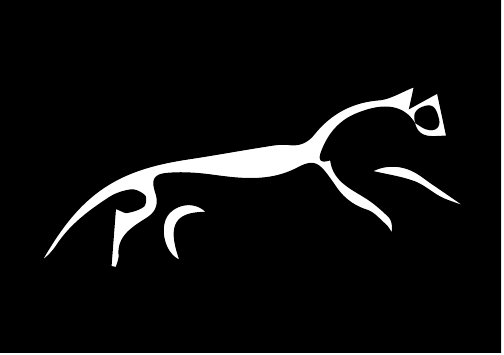
Rhiannon:
The Mare of Sovereignty
With Modron being the great mother, it is the guise of the goddess as Rhiannon, derived from the ancient British Rigantona, who represents the great queen. In Europe she was worshiped in the guise of Epona, the great mare. The four branches of the Mabinogi present a truly unambiguous and complete account of Rhiannon as one of Celtica’s most loved goddesses.
Her role as great queen is varied. We first encounter her as a strong, independent woman who appears on horseback from the mists of the Celtic otherworld to lead Pwyll, the hero of the first branch of the Mabinogi, on a chase to win her affections. Here she is seen to be acting against the wishes of her otherworldly family, and this rebellious nature is a powerful attribution that exemplifies the great queen’s independent spirit. Try as Pwyll may, his pursuit of her by horseback is never fast enough to catch her. Eventually, in frustration, he calls out to her to stop—and she does, chastizing him for not having asked earlier and exhausting his horse in the process.
There are two distinct periods in the tale where Rhiannon’s ties with the otherworld are thin and she moves fully and consciously into the world of humanity. Initially she is fully representative of the sovereignty of the land; the queen atop the horse, and her groom, Pwyll, by means of his marriage to Rhiannon, is perceived as being wed to the land itself. Rhiannon embodies the spirit of the land—she is powerful, sexually assertive, and fiercely independent; she is the epitome of the eternal goddess of land and sovereignty.
Within a year of their marriage, she gives birth to a son and dons the mother aspect of the Goddess, but—as in the tale of Mabon and Modron—her son is stolen from the crib at three days old. Rhiannon is wrongly accused by her servants of having destroyed and eaten her child, and in return she is punished. Forced to behave as a horse, she must offer to carry guests to the king’s court upon her back. Rather than being the queen in control of the horse, Rhiannon becomes the horse. In this guise she represents the calumniated wife, the mother wrongly accused, or the suffering queen; she becomes the workhorse.
Bereft and grieving, she accepts her punishment without complaint. Meanwhile, her son mysteriously appears in a stable on May’s Eve in place of a foal, and so begins Rhiannon’s association as equine goddess and her son as the divine foal god. Eventually they are reunited, at which she proclaims deliverance from her pryder, meaning “care or anxiety,” and thus the child is renamed Pryderi. In the third branch she appears again with her son, and together they are trapped in the otherworld and treated as horses.
Rhiannon’s attributions are simultaneously deific and painfully human. She is the Goddess made incarnate; she is the manner by which we can see through our own tribulations, our own suffering, and sense the divine within. Aspects of Rhiannon in her guise as horse goddess can still be seen within the traditional practices of Wales and Cornwall. The Welsh practice of the mari lwyd, where a horse’s skull dressed in ribbons hunts from house to house, mimics Rhiannon’s hopeless search for her missing foal, and the Cornish “Obby Oss” evokes a distant memory of the divine horse goddess.
She is the nightmare, the whispers of wisdom that come to us in dreams. She is indicative of many traits of the human condition; she instills wisdom and guides her husband to be of greater care; she is loving, faithful, and accepting of her fate. She is the sorrowful queen, the embodiment of grief and bereavement, compassion and humility. Aligning oneself to Rhiannon is to wander into her halls of teaching, of taking counsel before her; by listening to her wisdom, we learn much about our own inherent humanity and of the source of the Goddess that lives within us.
As a magical ally, Rhiannon connects us to the land beneath our feet and our place in time and tribe. She is an effective ally for magic concerning deep emotional healing and help, grief and heartbreak being her forte.
spell
Grief and Bereavement with rhiannon
We all will experience a loss at one point or another in our lives, and with it the ensuing descent into grief and bereavement. All forms of separation and loss can initiate a grieving process, whether losing a job, a home, the children flying the nest, the end of a relationship, or indeed a death. This spell is a simple little ritual that can be done for yourself or for someone who you know is suffering with grief. It does not serve to vanquish or lessen the grief but instead to bring about an acceptance and understanding of it.
The symbol used is based on the White Horse of Uffington in southern England. There are several white horses carved into the hills of Britain, and although their actual meaning is lost to the mists of time, there is no doubt that they were sacred. Rhiannon, Epona, and Rigantona are all representative of the horse, and many British Pagans perceive these figures to be emblematic of the Mare of Sovereignty.
For this spell you will need a small, smooth pebble and some permanent markers or paint. At the appointed time in the spell’s verse, you will draw the following image. The entire spell is in the form of an englyn, instructions are given in italic verse, and the lines with quotation marks around them are to be spoken out loud in the form of a chant.

As soon as the sun has set its face over the horizon, take to your altar, extinguish all lights, and place a single unlit candle within your cauldron. If you wish, perform the triskelion ritual from chapter 5 at this point. As the light fades and shadows descend upon your space, be inspired by the following englyn and call the image of Rhiannon to mind:
Golden hair sweeps o’er tear-stained cheeks, blood stains soft pink skin
A heart breaks beneath the strain of loss, a silent scream within.
At her side a stone-firm mount and men who gather near
To beat her sides with booted feet, at the horse they laugh and jeer.
An image bright to pierce the night, to stone now take to paint
The image of a great white horse to ease thine heart’s complaint.
Within the depths of cauldron deep, a light bursts forth to shine
O’er candlelight, the stone in hand, these words shall now be thine:
“Rhiannon, goddess of the horse,
My suffering calls to thee,
To broken hearts and tears give pause,
Understanding come to me.”
The goddess in her suffering smiles a knowing look so fair
And wisdom ancient is summoned forth by form of sacred mare.
To live, to hurt, is all the same, and healing comes with time
Look to the horse, Rhiannon wise, and call this ancient rhyme:
“Rhiannon, goddess of the horse,
My suffering calls to thee,
To broken hearts and tears give pause,
Understanding come to me.”
With single light that pierces night, the goddess hears your cry
With loss will always come the plea of never knowing why.
But know Rhiannon, ever wise, will walk and hold thy hand
And embrace thy suffering in the lap of knowing in the land.
“Rhiannon, goddess of the horse,
My suffering calls to thee,
To broken hearts and tears give pause,
Understanding come to me.” 30
Remain in the space, calling and singing, chanting or uttering incantations to Rhiannon. As the ritual loses its energy, let the power of it seep into the painted stone you hold in your hands. If you are the one in sufferance of grief, carry it with you or place it under your pillow. If the spell was performed for another, give them the stone and explain its intention. The spell is done.
Rhiannon
Spiritual Function: Teaches us about the importance of humility, acceptance, finding the sacred within the land, the ability to listen and respond, and being held accountable.
Magical Ally Function: For magic and spells that require the energy of a particular location; for healing, grief, and bereavement spells and magic; useful as an ally to enter the realm of the fair folk and to see between the worlds.
30 Englyn written by me.